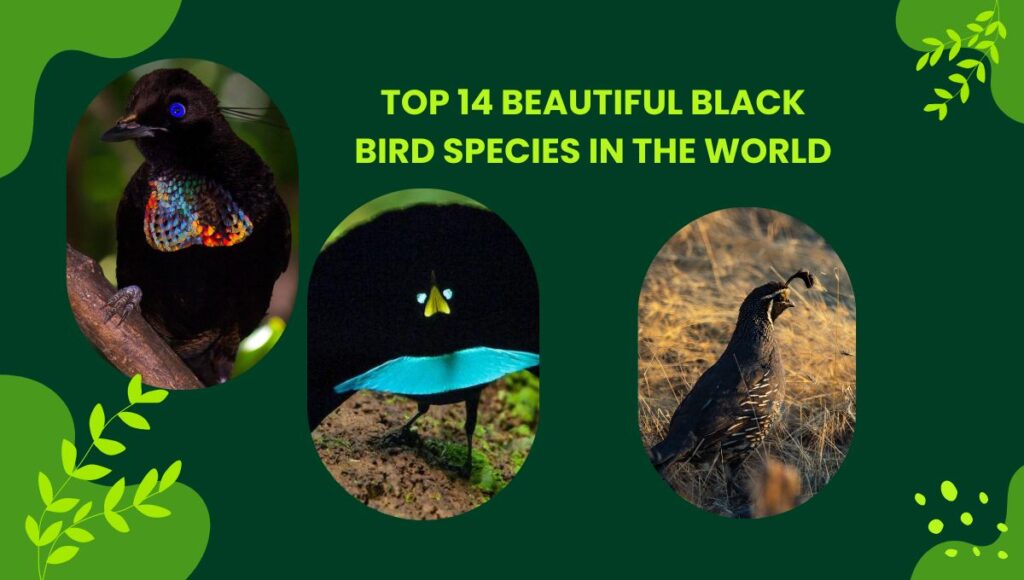There are so many black bird species in the world. Today, we are discussing 14 black birds.
This article covers many different species of blackbirds, their scientific classification, colour, size, food, habits, how to identify them, etc.
Top 14 Types of Black Bird Species:
We will introduce you to 14 beautiful types of blackbirds, including the boat-tailed grackle, American crow, black-billed magpie, etc.
No 14: The boat-tailed grackle:

These bird species live in eastern America, Mexico and Florida.
| Feature | Description |
| Name | Boat-tailed Grackle |
| Scientific Name | Quiscalus major |
| Colour | Males: Shiny black; Females: Brown |
| Size | About 16 inches (40 cm) long |
| Habitat | Wetlands, marshes, and coastal areas |
| Diet | Insects, small fish, fruits, and seeds |
| Sound | Loud, harsh calls that sound like “squawks.” |
| Behaviour | They like to forage in groups and often walk on the ground |
| Nest | Built-in tall reeds or trees, usually near water |
| Migration | Mostly stay in the same area, but some may move short distances |
| Unique Fact | Males have long, boat-shaped tails that they fan out during displays! |
Birds of this species length from 15 to 18 inches and weigh between 150 grams. Their diet consists mainly of various seeds, grains and nuts.
Males of this species have black and blue colour features, and females have black wings and a light brown colour on the chest.
Their eye colour is sometimes brown or yellow. Each of these birds has a long tail resembling the English letter V.
Read More: Top 20 best and unique Male bird names for your birds
No 13: Red-Winged Blackbird:

Red-Winged Blackbird looks beautiful. These blackbird species are found in North and Central America.
These black bird species are around 9 inches and weigh 80 to 90 grams.
The Red-Winged Blackbird’s main food during breeding season is small insects and spiders. Other times, they mostly eat grains, small insects, and seeds.
Male Red-Winged Blackbirds are black and have beautiful red patches on their shoulder feathers.
The females have brown, black and white feathers. Around their beaks, they have a yellow colour.
No 12: Brewer’s Blackbird

These Black Bird species live in North America and the west side of the United States.
| Feature | Description |
| Name | Red-Winged Blackbird |
| Scientific Name | Agelaius phoeniceus |
| Colour | Males: Black with red and yellow shoulder patches; Females: Brown and streaked |
| Size | About 9 inches (23 cm) long |
| Habitat | Marshes, wetlands, and grassy areas |
| Diet | Insects, seeds, and grains |
| Sound | It’s a loud, musical song that sounds like “conk-la-ree.” |
| Behaviour | Males defend their territory with loud calls and displays |
| Nest | Built low in marsh plants or shrubs |
| Migration | Some stay year-round; others migrate south in the winter |
| Unique Fact | Males flash their red wings to attract mates and warn off rivals! |
Brewer’s Blackbird length is 9 inches, weighing up to 50 grams. These species of birds’ main food is seeds, insects and berries.
Brewer’s Blackbird’s main habitats include marshes, wetlands, and grassy areas. It can make a loud sound like “conk-la-ree.”
Males’ bodies and heads are round, their eyes are yellow, and their beaks are wide. Females have a brown colour, dark eyes and wide beaks.
Some black bird species migrate to the south in the winter, and some stay year-round.
Read More: Top 10 Interesting facts about Parrot birds
No 11: Black-billed Magpie
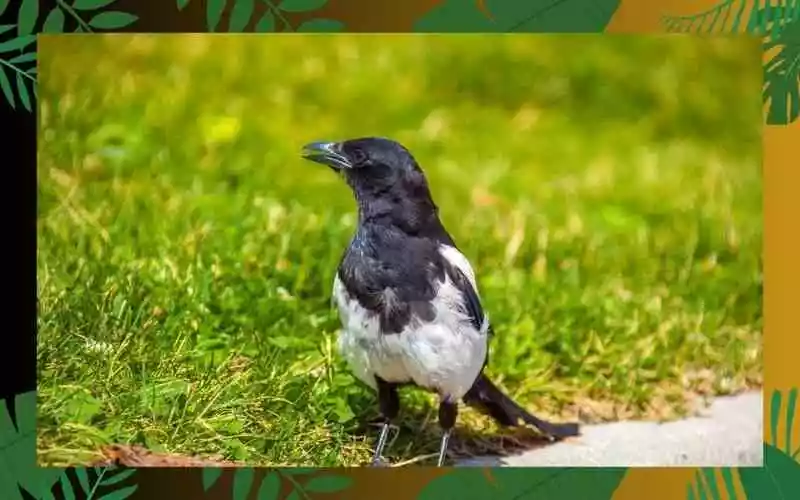
The Black-Belled Magpie is a species of blackbird that lives in west North America. It grows 24 inches and weighs around 170 grams.
| Feature | Description |
| Name | Black-billed Magpie |
| Scientific Name | Pica hudsonia |
| Colour | Black and white with iridescent blue-green on wings and tail |
| Size | About 18 inches (46 cm) long |
| Habitat | Open woodlands, grasslands, and near human settlements |
| Diet | Insects, small mammals, fruits, and seeds |
| Sound | A loud, chattering call that sounds like “mag-mag-mag.” |
| Behaviour | Known for collecting shiny objects and building large nests |
| Nest | Big, dome-shaped nests built in trees or shrubs |
| Migration | Mostly stay in the same area year-round |
| Unique Fact | Magpies are highly intelligent and can even recognise themselves in mirrors! |
The Black-billed Magpie’s main diet includes berries, many fruits, small insects, nuts, seeds, and garbage wasted.
These black magpies look beautiful with white and black colour combinations on their body.
These bird species have a dark black beak, black head and legs.
They look beautiful when they spread their wings because of the light blue and white colour combinations.
These black bird species love to stay in open woodlands, grasslands, and near human places. They make a call that sounds like “mag-mag-mag.”
They make a big nest in trees and shrubs. Unlike other migratory birds, they stay in the same area year-round.
No 10: American Crow
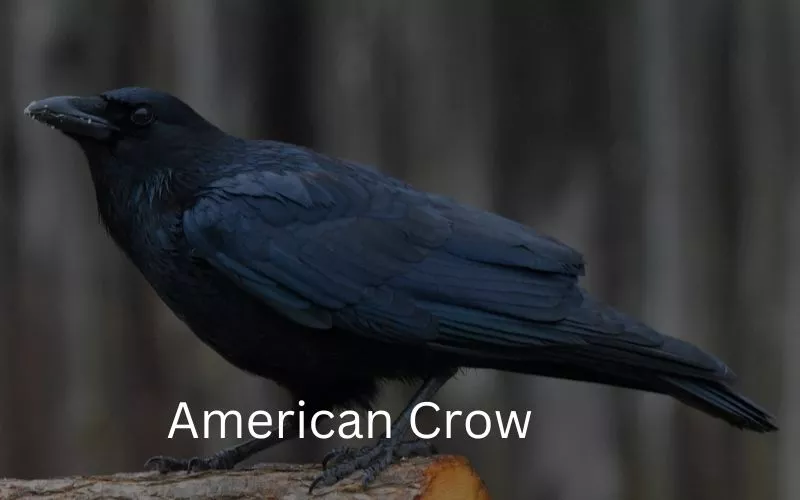
The American Crow lives across the United States of America.
| Feature | Description |
| Name | American Crow |
| Scientific Name | Corvus brachyrhynchos |
| Colour | All black, including feathers, beak, and legs |
| Size | About 17-21 inches (43-53 cm) long |
| Habitat | Forests, fields, cities, and suburban areas |
| Diet | Omnivorous: eats insects, fruits, nuts, small animals, and even garbage |
| Sound | Loud “caw-caw” calls that are easily recognisable |
| Behaviour | Highly social, often seen in large groups, and known for problem-solving |
| Nest | Built high in trees, made of sticks and lined with soft materials |
| Migration | Some migrate short distances, but many stay in the same area year-round |
| Unique Fact | American Crows are very smart and can use tools to get food! |
This large black bird species’ length is around 21 inches and weighs up to 1 pound.
The American Crow eats other small birds, insects, frogs, rodents, and seeds.
These birds’ feathers are extremely black. These black bird beaks are so strong, large and black.
Their main habitats include Forests, fields, cities, and suburban areas. Some blackbird species migrate short distances, and many stay in the same area.
These blackbirds are highly social and known for their problem-solving skills.
No 9: Black Swift
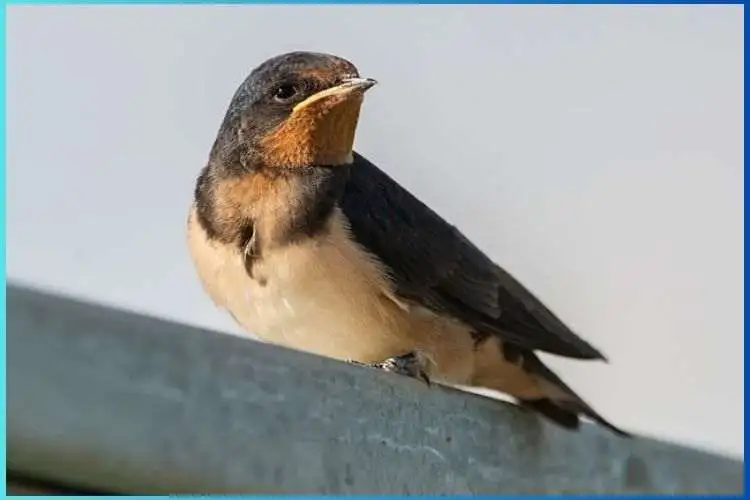
| Feature | Description |
| Name | Black Swift |
| Scientific Name | Cypseloides niger |
| Colour | Dark, sooty black all over |
| Size | About 7 inches (18 cm) long |
| Habitat | Nests in cliffs near waterfalls or in sea caves |
| Diet | Insects caught while flying |
| Sound | Soft, high-pitched “swee-swee” calls |
| Behaviour | It spends most of its life in the air, only landing to nest |
| Nest | Hidden on cliff ledges or in caves made of moss and mud |
| Migration | Migrates long distances to South America in the winter |
| Unique Fact | Black Swifts are some of the fastest-flying birds and are rarely seen resting! |
The Black Swift was found in North America, the United States, Mexico, and Brazil.
These species of black bird length is 7 inches and weigh up to 50 grams.These black birds look like fighter jets when flying.
Their wings and tails are curved, similar to the English letter ‘W’. These black bird species love to inhabit cliffs near waterfalls and sea caves.
Their main diet is insects they catch while flying. They also make a high-pitched soft sound like “swee-swee.”
The Black Swifts are migratory birds. They migrate long distances to South America during the winter.
Read More: 10 interesting facts about Myna Bird | Myna name, food, nest
No 8: American Coot
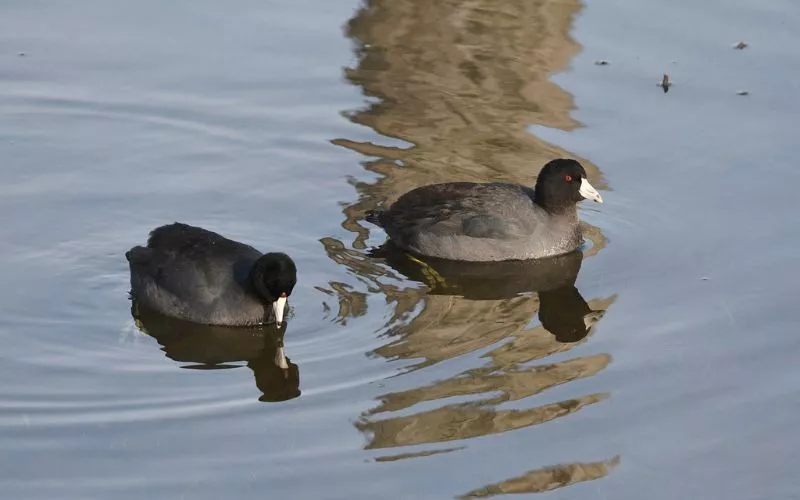
| Feature | Description |
| Name | American Coot |
| Scientific Name | Fulica americana |
| Colour | Dark grey to black body with a white beak and forehead |
| Size | About 15-17 inches (38-43 cm) long |
| Habitat | Freshwater lakes, ponds, marshes, and rivers |
| Diet | Aquatic plants, algae, insects, and small fish |
| Sound | A variety of clucks, croaks, and grunts |
| Behaviour | They are often seen swimming like a duck, but they have lobed toes instead of webbed feet |
| Nest | Built-in shallow water, made of plants and anchored to reeds |
| Migration | Some populations migrate to the southern U.S. or Mexico in winter |
| Unique Fact | American Coots can run across the water’s surface to take off for flight! |
The American Coot is a black bird with a white beak and forehead. It is 15 to 17 inches long.
American Coots love to stay in freshwater ponds, rivers, lakes, and marshes.
Their main diet includes plants, insects, and small fish. They make sounds like “clucks, croaks, and grunts.”
They build their nests in shallow water with plants. Some black bird species migrate to the southern U.S. or Mexico in the winter.
No 7- Black Phoebe
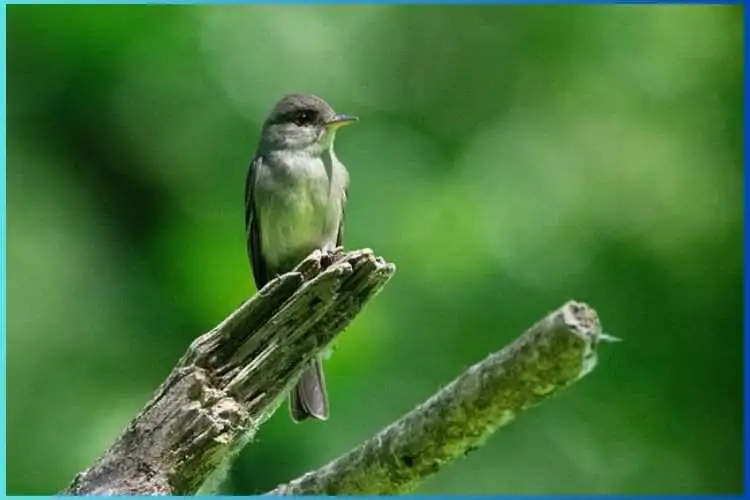
| Feature | Description |
| Name | Black Phoebe |
| Scientific Name | Sayornis nigricans |
| Colour | Mostly black with a white belly |
| Size | About 6.5 inches long |
| Habitat | Lives near water, like streams and ponds |
| Diet | Eats insects by catching them in the air |
| Sound | Makes a sharp “tsip” or “pee-wee” sound |
| Behaviour | Bobs its tail up and down while sitting on low branches or rocks |
| Nest | Builds mud nests under bridges or roofs |
| Migration | Usually stays in the same place all year, but some move to warmer spots in winter |
| Unique Fact | Black Phoebes are great at catching bugs and often return to the same spot after hunting! |
Black Phoebe is a black bird with a white belly. The scientific name of this bird is Sayornis nigricans.
These black birds are 6.5 inches long. They love to inhabitants near water sources.
Their main diet includes insects that they catch while flying. They make a sharp “tsip” or “pee-wee” sound.
Black Phoebe built mud nests under bridges or roofs. Some of these black bird species stay in the same places all year, but some migrate to warmer spots in winter.
No 6- Bronze Cowbird

| Feature | Description |
| Name | Bronze Cowbird |
| Scientific Name | Molothrus aeneus |
| Colour | Males: Shiny black with a bronze sheen; Females: Dark brown |
| Size | About 8-9 inches long |
| Habitat | Grasslands, farms, and open woodlands |
| Diet | Seeds, insects, and grains |
| Sound | A sharp “chuck” or “whistle” sound |
| Behaviour | Lays eggs in other birds’ nests for them to raise |
| Nest | Does not build its own nest; uses other birds’ nests |
| Migration | Migrates to warmer areas in winter, like Mexico and Central America |
| Unique Fact | Bronze Cowbirds are brood parasites, meaning they trick other birds into raising their chicks! |
Bronze Cowbirds are black bird species with shiny black bodies. Males have shiny black bodies, while females have dark brown bodies.
These black birds grow 9 inches long. They inhabit open woodlands, farms, and grasslands.
Their main diet includes insects, seeds, and grains. They make a sharp sound like “chuck” or “whistle.”
They have rude behaviour, like laying eggs in other birds’ nests. Bronze Cowbirds migrate to warmer areas during winter.
No 5: Swallow-Tailed Kite

| Feature | Description |
| Name | Swallow-Tailed Kite |
| Scientific Name | Elanoides forficatus |
| Colour | White with black wings and a deeply forked tail |
| Size | About 16-20 inches long |
| Habitat | Forests, wetlands, and open woodlands |
| Diet | Insects, small reptiles, and occasionally small birds |
| Sound | High-pitched, soft calls |
| Behaviour | Glides and soars in the air, often seen circling or hovering |
| Nest | Builds nests in tall trees, using sticks and leaves |
| Migration | Migrates from North America to Central and South America in winter |
| Unique Fact | Swallow-tailed kites have long, elegant tails that help them manoeuvre in flight! |
The Swallow-Tailed Kite lives in Central America, South and South-east America.
These species of birds grow 27 inches and weigh 1 pound. They mostly eat insects, small amphibians, snakes and birds.
These black birds have long wings with forked feathers. Their heads, underbodies, and chests are white, and the tops of their wings are pure black.
Read More: Why Do Crows Attack Other Crows?
No 4- Bobolink

| Feature | Description |
| Name | Bobolink |
| Scientific Name | Dolichonyx oryzivorus |
| Colour | Males: Black with a white back and yellowish nape; Females: Brown and streaked |
| Size | About 6.5 inches long |
| Habitat | Grasslands, meadows, and fields |
| Diet | Seeds, insects, and grains |
| Sound | A distinctive, bubbly song that sounds like “bob-o-link.” |
| Behaviour | Often seen hopping on the ground and flying in graceful arcs |
| Nest | Builds nests on the ground, hidden in tall grasses |
| Migration | Migrates from North America to South America in winter |
| Unique Fact | Male Bobolinks are known for their beautiful, cheerful songs during mating season! |
Bobolink is a black bird with a black body. Males have black with a white back, while females have brown bodies.
These black birds grow 6 to 7 inches long. They prefer grasslands, meadows, and fields for their habitat.
They like to eat insects, seeds, and grains. They make a sound like “bob-o-link.”
They build nests on the ground and hidden places in tall grasses. They migrate from North America to South America in winter.
These beautiful black birds are known for their beautiful songs.
No 3: Common Raven

| Feature | Description |
| Name | Common Raven |
| Scientific Name | Corvus corax |
| Colour | All black, including feathers, beak, and legs |
| Size | About 24 inches long (60 cm) |
| Habitat | Forests, mountains, and open country |
| Diet | Omnivorous: eats insects, small animals, carrion, and food scraps |
| Sound | Deep, resonant croaks and clicks |
| Behaviour | Highly intelligent, often seen flying in acrobatic displays |
| Nest | Builds large, sturdy nests in high places like cliffs or tall trees |
| Migration | Mostly stay in the same area year-round, but some move short distances |
| Unique Fact | Common Ravens are known for their problem-solving skills and playful behaviour! |
The Common Raven lives all across the North Hemisphere. These species of big birds are 26 inches long and weigh around 4 pounds.
Common Raven mostly eat small birds, bird eggs, rodents, grain and also seeds. The Common Raven looks like the American Crow.
The only way you can identify that is shaggy feathers around the raven’s neck.
No 2: Yellow-Headed Blackbird
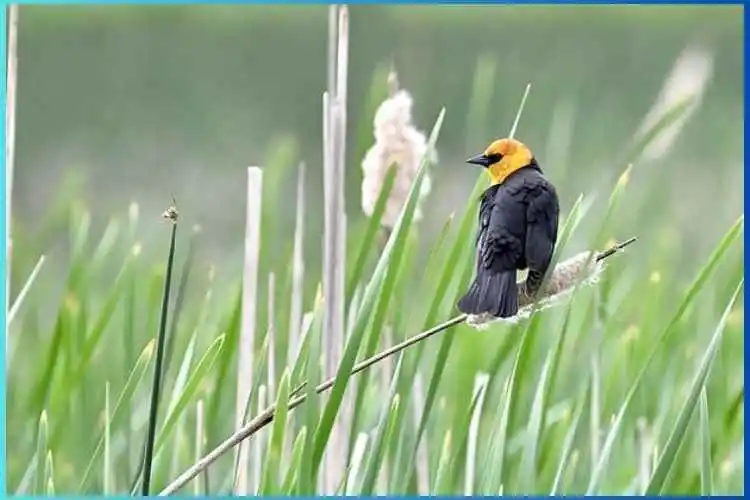
| Feature | Description |
| Name | Yellow-Headed Blackbird |
| Scientific Name | Xanthocephalus xanthocephalus |
| Colour | Males: Bright yellow head and chest with black body; Females: Brown and streaked |
| Size | About 8.5-10 inches long |
| Habitat | Marshes, wetlands, and grassy areas |
| Diet | Insects, seeds, and grains |
| Sound | A distinctive “yank-yank” call |
| Behaviour | Often seen in groups, males perform displays to attract mates |
| Nest | Built-in dense vegetation, often in reeds or cattails |
| Migration | Migrates to warmer areas in winter, usually to Mexico |
| Unique Fact | Male Yellow-Headed Blackbirds are easily recognised by their bright yellow head and chest! |
The Yellow-Headed Blackbird lives in the central and western United States and in California near the Mississippi River.
These species of blackbirds grow 4 inches and weigh almost 50 grams.
The males have a black body, yellow head and chest, and black and white wings. The females have a brown head and body, and their chests are yellow.
No 1: European Starling

| Feature | Description |
| Name | European Starling |
| Scientific Name | Sturnus vulgaris |
| Colour | black with speckles; in winter, it often looks brownish |
| Size | About 8.5-9 inches long |
| Habitat | Urban areas, parks, and open fields |
| Diet | Insects, fruits, seeds, and garbage |
| Sound | A variety of harsh and melodic calls mimic other birds and sounds |
| Behaviour | Often seen in large flocks, very social and noisy |
| Nest | Builds nests in trees, buildings, or other sheltered spots |
| Migration | Some migrate short distances; others stay year-round |
| Unique Fact | European Starlings are great mimics and can imitate a wide range of sounds! |
European starlings are songbirds. Shakespeare first brought them to North America in the 19th century.
These birds have white spots in winter and turn brightly coloured again in summer.
Birds of these species are 8 to 9 inches long and 56 to 100 grams in weight.
The food of these species of birds includes all kinds of seeds, different kinds of fruit nurses and small insects.
This bird species’ beak turns yellow in summer and grey in winter.
One of the other characteristics of European starlings is that they can make other 20+ sounds.
How to Identify:
- The birds of this species are small in size, and their feathers are deep black.
- These birds always move together in groups.
- Birds of this species have some whitish spots on the black feathers and yellow spots around the beak.
- The European’s Darling lives in low marshes and nests in tree trunks.
Conclusion
These 14 black bird species show how good life can be. Each bird has special features and behaviours, from the shiny Brewer’s Blackbird to the unique Swallow-Tailed Kites. They make our world beautiful with their colours, songs, and habits.

